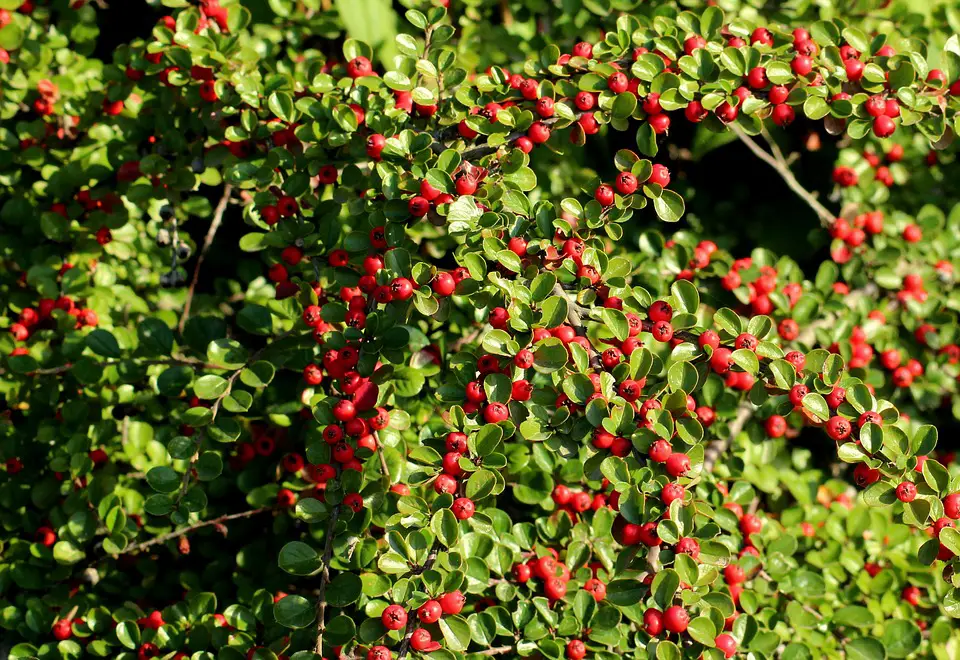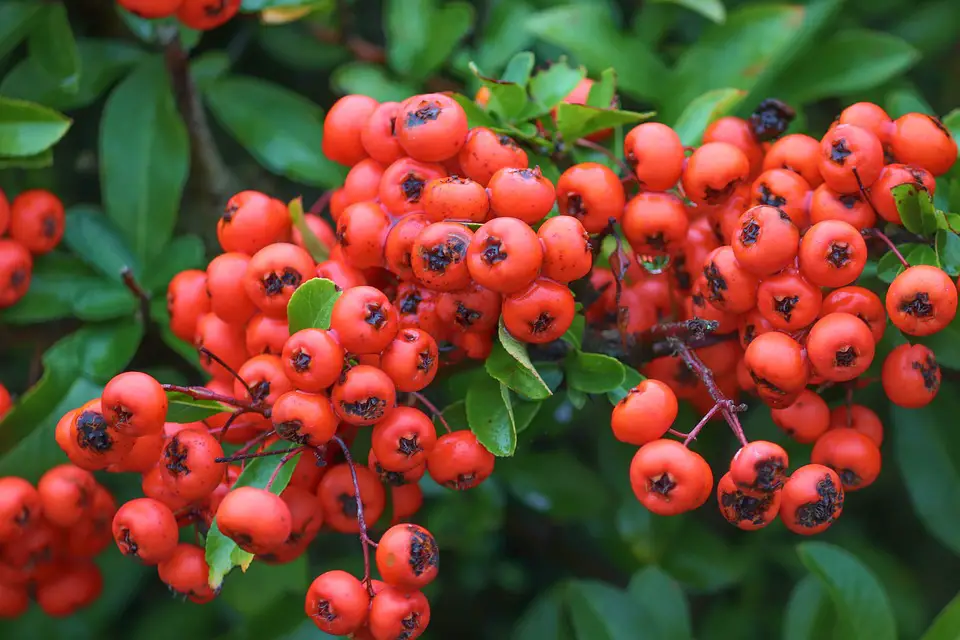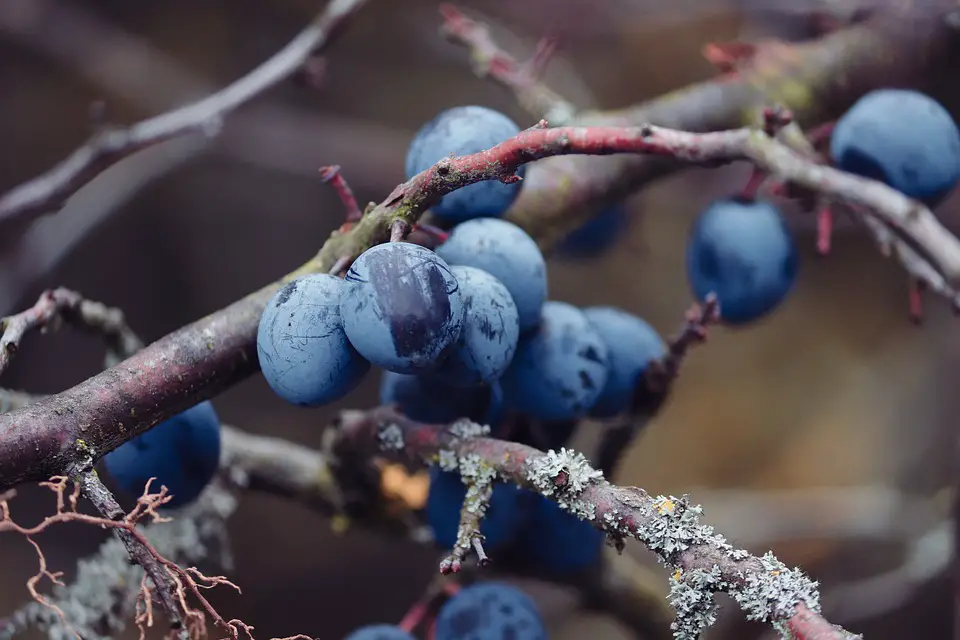As autumn rolls around, the many shrubs and bushes in my garden come alive with countless berries. Their attractive shades of oranges, yellows, reds, and black entice birds, humans, and insects and decorate my garden like fairy lights on a Christmas tree.
Berries are a vital source of nutrition to garden birds, especially in the winter if frost and snow settle.
Many plants coat their seeds in a juicy pith to make them stand out more to all wildlife, especially birds.
Birds eat the whole thing; they digest the fleshy part, and the seeds pass through their digestive tract before being dropped somewhere, possibly far from the parent plant. In the right conditions, the seeds germinate and grow into healthy shrubs. It’s no coincidence that fruiting shrubs appear next to fences and hedges; birds favourite perching spots!
The birds and the berries are equally reliant on each other; luckily, there are several varieties to choose from, right up until the end of winter.
Garden birds enjoy the berries of almost any shrub; they are drawn to bright red and orange ones. Blackberries, blackcurrants, sloes, and cherries are fruits eaten by many species in a bid to survive harsh winters.
Table of Contents
Cotoneaster

The cotoneaster is a popular shrub found in many gardens, including mine. It is one of the favourites amongst garden birds and usually the first to be stripped of its berries.
It produces an abundance of berries, beginning as the temperature drops.
The cotoneaster bush tends to be invasive, and if not pruned, overtakes the flower bed. My best advice is to plant the more compact horizontalis variety. It will still require
occasional pruning. If planted near a wall or fence forms an attractive hedge as it grows upwards.
How to recognise a cotoneaster berry
The evergreen shrub has elliptical leaves, dark green on top and white on the underside. When the cup-shaped flowers have died off, they produce an abundance of small red berries reminiscent of the holly bush. The dark green and red contrast beautifully.
Why is cotoneaster a good shrub for birds?
Not only is cotoneaster a rich source of nectar and pollen for the bees and butterflies, but it also provides an excellent habitat or shelter spot safe from predation.
Berries are usually the first ready, ideal if an unexpectedly cold snap occurs. They last until late winter, providing much-needed nutrition for an entire season.
Which birds enjoy cotoneaster berries?
There are around 30 garden bird species that enjoy cotoneaster. Most are those that are fruit eaters at other times of the year.
- Waxwings If a flock spot your shrub, grab your camera. They are relentless and won’t stop the feeding frenzy until the bush is stripped bare.
- Blackbirds
- Thrushes
- Doves
- Robins
Holly

The holly bush is one of the most easily identified berry-producing evergreens in the garden – probably due to its links with all things Christmas.
Only female holly bushes bare berries, but they still need to be near a male bush to pollinate them.
The Chinese holly variety is the exception to the rule; she is a self pollinator, no male required. It produces berries of various shades of red, orange, and yellow.
Most female species have a coordinating male variety. For instance, the Blue Princess that has greenish-blue leaves and produces deep red berries needs the Blue Prince variety for fertilisation.
Similarly, The Golden King and Golden Queen pair well to produce vibrant red berries, with deep green leaves edged with gold. Strangely, the King is the female plant, and the Queen is male!
How to recognise the holly berry
The most traditional holly plants have variegated, spiky leaves of the deepest green. They produce bright red berries throughout the winter to satisfy the hungry birds.
Holly berries ripen during autumn, although most birds wait until mid-late winter before they plunder them. They are especially good at attracting some of the smaller species of birds.
Why are holly berries good for birds?
The small red berries have high nutritional value to birds; but are toxic to most other species, including humans. Birds are safe in the knowledge that no other creature will attempt to steal their snacks.
The holly bush provides year-round cover for roosting birds; the sharp edges of the leaves keep many predators at bay.
Although toxic to humans, birds seem to suffer no ill effects from the holly berry. It is believed that several cold winters reduce the toxicity to safe levels for their small stomachs to digest.
Which birds enjoy holly berries?
It depends upon your location, but garden birds that enjoy holly berries include;
- Mistle thrush They are protective of holly bushes and fend off other birds to keep their find all to themselves.
- Robin
- Redwing
- Song thrush
- Blackbird
- Fieldfare
Pyracantha

Pyracantha is the thornier cousin of the cotoneaster shrub. It grows in carpet fashion along the ground or can just as easily be trained up a wall. During the spring, the pollinators spend lots of time retrieving the nectar from the countless white flowers.
In mid to late autumn, pyracantha becomes of particular interest to the birds when it becomes covered in bunches of small red and orange berries.
There are several varieties of pyracantha. Flava produces bright yellow berries, and unsurprisingly, Orange Glow creates orange berries.
How to recognise the pyracantha berry
The berries grow in abundance; large bundles of them cluster between small, dark green leaves.
Pyracanthas are notably thorny; never attempt pruning without wearing your gardening gloves.
Why are pyracantha berries good for birds?
They are some of the smaller berries available in the garden and much more inviting to the smaller garden birds.
The bushy, evergreen pyracantha shrub provides lots of cover all year round.
The branches are home to many tiny insects, yet another food source for the birds.
Which birds enjoy pyracantha berries
The berries are of great nutritional value to many birds, but the smaller ones seem to enjoy them most.
My pyracantha bush has many starling visitors in autumn and winter. They hide in the nearby willow and dart out at regular intervals to get their fill.
- Starlings
- Finches
- Sparrows
Dogwood

Dogwood might sound more familiar to you as a large tree, one that can reach heights exceeding 10m. The very same plant has a broadleaf shrub variety that remains a manageable size with regular pruning.
It has striking red branches and crimson leaves, making it a lovely ornamental addition to any garden. Birds are probably more attracted to the red twigs, only to find copious amounts of dark berries when they land.
It flowers through spring and summer before producing fruit in the autumn that lasts long into winter.
How to recognise dogwood
Dogwood is easily recognised, particularly late in the year. It has deep purple, almost black coloured berries. They grow in small clusters from deep red stems – a delightful flash of colour in otherwise dull gardens.
Why are dogwood berries good for birds?
They are another berry high in antioxidants and packed with nutrients. Dogwood berries are favoured by migrating birds and, once they find a healthy supply, will return multiple times to help prepare for their trip.
Which birds enjoy dogwood berries
Many birds eat the fruit of the dogwood, including;
- finches
- thrushes
- waxwings
- woodpeckers
- robins
Blackthorn

The blackthorn is a shrub for which we should all give praise; it bears fruits called sloes, the ones used to make sloe gin!
It is a fast-growing shrub that forms an impenetrable hedge of interwoven branches. Not only does the thorny thicket provide excellent nesting sites for birds, but the foliage is an integral part of moth and caterpillar diets.
Sloes provide a feast from mid-autumn onwards. They are too bitter for humans to eat yet, but birds seem to manage just fine.
They are one of the larger berries that perturbs some smaller songbirds.
How to Recognise the Blackthorn
The blackthorn is small, stubby, and thorny with lots of deep purple and black twigs. They have narrow leaves, and in the winter, leaf buds appear along the spines.
The berries appear during the autumn; they are large, approximately 1cm across. They are blueish purple with a dusty coating. The dust is a yeast bloom that gives them a natural UV light reflection that attracts birds.
Why are Blackthorn Berries Good for Birds
They are larger berries and more appealing to bigger birds, particularly those with hooked beaks designed for seed-eating.
They are plump and juicy; birds need to eat far fewer compared with other smaller berries. They conserve energy by not having to be on the move reaching for food.
Which Birds Enjoy Blackthorn Berries
Several birds eat sloes from a blackthorn hedge;
- blackbirds
- thrushes
- hawfinches
- waxwings
Other Berries Birds Eat – at a glance.
Hawthorns – A favourite of blackbirds, finches, and thrushes who devour the orange berries in their entirety. Hawfinches eat the pulp, leaving the inner seed behind.
Poison Ivy – Toxic to humans and many other wildlife creatures, Poison Ivy is enjoyed by many bird species.
Viburnum opulus – Copious amounts of small, vivid red berries grow in clusters throughout winter. They are a favourite of thrushes and bullfinches.
Wild cherry – instantly recognisable from its colourful blossom in spring, it bears lots of fruit in late autumn. Cherries dangle from the branches, and most bird species devour them, though most eat the flesh and leave the seed behind.
Rowan – rowan berries are easy for all birds to spot as their scarlet red contrasts perfectly with deep green leaves. The shrub produces clumps of small red berries well into November. They are quickly depleted by beady-eyed starlings and blackbirds.
Other Ways to Feed Berries to the Birds
Some birds eat fruit and berries all year round but, in preparation for winter and often long migratory flights, even the seed and insect eaters change their diet.
Berries are good for birds because they are rich in antioxidants. They help combat the stress and inflammation put on their bodies during the winter flights and survival battle.
When preparing for migration, some birds daily eat as much as three times their body weight in berries!
If you don’t have any garden space or shrubs, it is still possible to feed berries to the birds.
Buy a designated fruit feeder or leave a handful of blueberries, blackberries, or cherries on the bird table.
The best, and most fun way, is to make homemade suet balls or blocks. It’s easy to do; just read my article.
Lots of chopped berries turn the suet pink and hopefully make them more inviting to the birds.
Final Thoughts
Birds are notoriously drawn to red and orange berries first, but that doesn’t mean they’ll ignore any of the purple, black, or white berries you have planted for them.
Be patient; when they have had their fill of the red ones, they will progress around the garden.
Expect to see different birds eating berries in winter than you would in summer. Even the hardiest seed and insect eaters need rich antioxidant-filled fruit to prepare for a harsh winter or long flight south.
